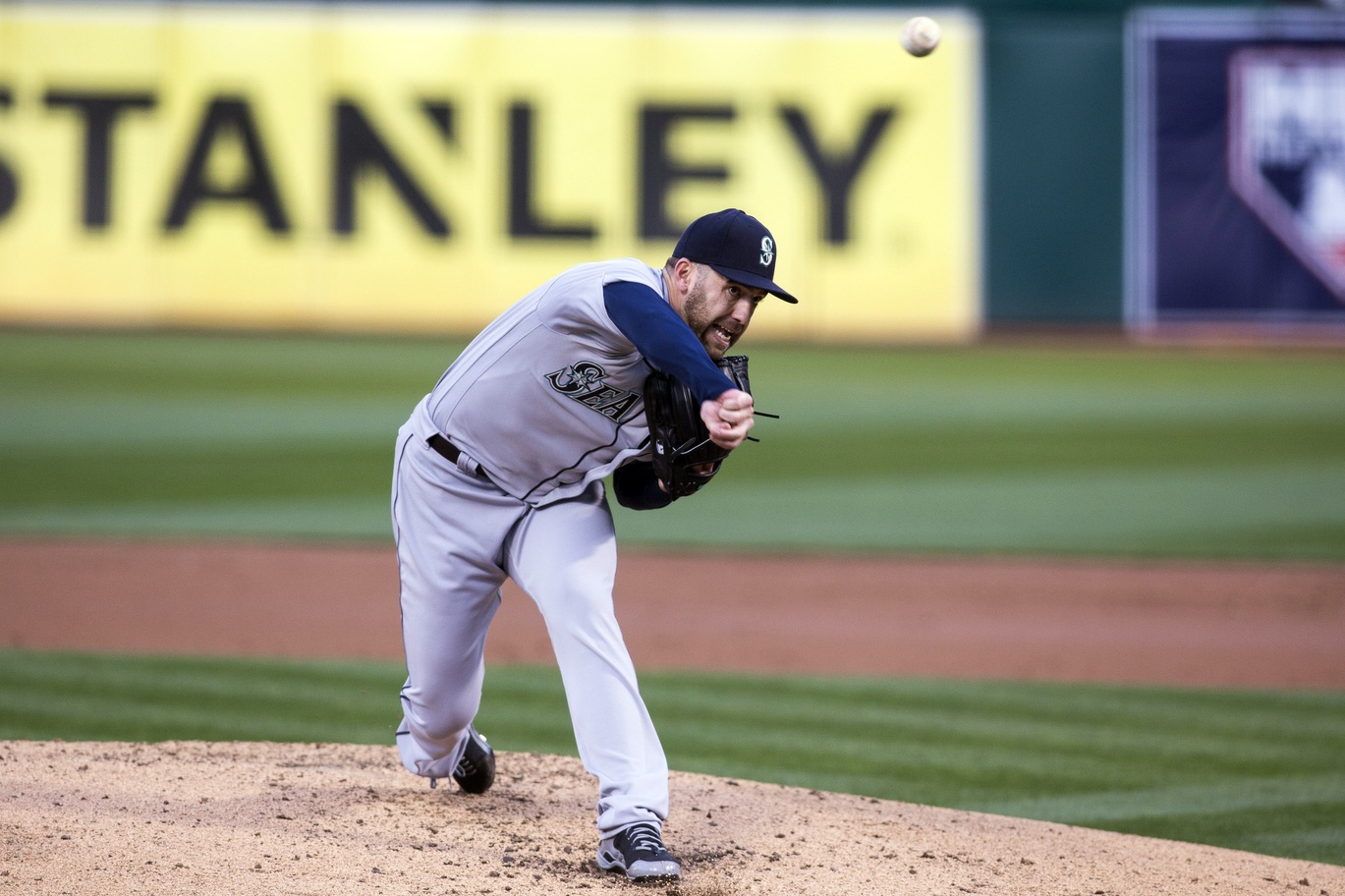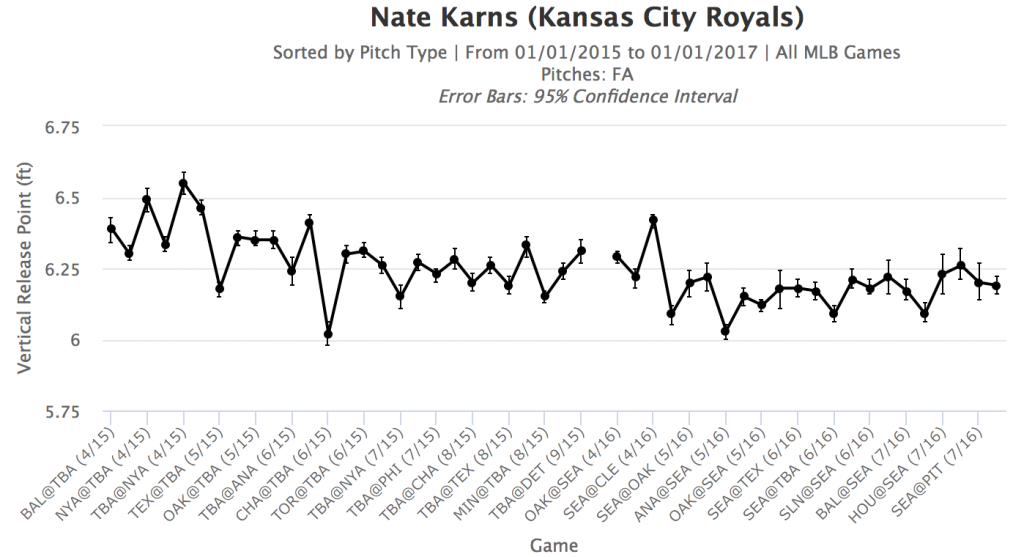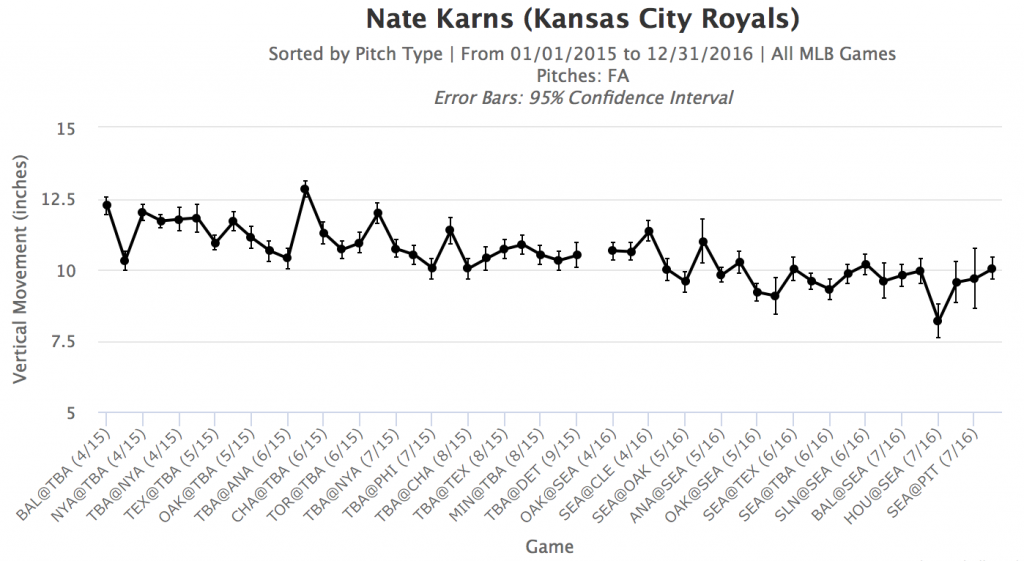Think of the greatest duos in history. Peanut butter and jelly. Batman and Robin. Now picture Nate Karns and his fastball and curveball. (Fine. Technically that’s a trio, but we’re focusing on Karns’ pitches today. OK?)
Hyperbole? You bet. How else would you be snookered into reading an article about Karns and his pitch selection? And now, just a few days removed from being anointed as the fifth starter for the Royals, it’s time to shine a light on the right arm at the back of the rotation.
When the Royals acquired Karns in January, he was thought to be a lock for the rotation. Then he wasn’t. Such is life in the winter where one move portends a signal of certainty until another move throws that certainty into a chasm of the unknown. That’s what spring training is all about. To throw all your cards on the table, add a few more, then sort them into a coherent 25 man roster.
The uncertainty came from the signing of free agent Travis Wood. (Making the assumption here that Jason Hammel was signed as the replacement for the late Yordano Ventura.) It also came from the fact the Royals were paying Chris Young $5.75 million this year in what is looking like a regrettable deal. Thus, a mixer of fifth starter options were in play.
It shouldn’t have really been a competition, but we do need things to discuss in the spring. Let’s face it, another year of “Who will play second base?” generates a little March Madness of it’s own. The Royals made quick work of the suspense by revealing last week that it would be Karns at the back of the rotation.
For the uninitiated, a brief refresher. Karns was drafted out of high school by the Houston Astros in the 10th round. He passed up an opportunity to sign and instead enrolled at Texas Tech. After three years at Tech, he was drafted again. This time by the Washington Nationals and this time in the 12th round. He made his major league debut for the Nats in 2013 then was traded to the Rays just ahead of the 2014 season. After two years in the Rays system, he was on the move again, this time to Seattle. And now, Kansas City.
That’s quite the travelogue for a pitcher who turned 29 last November.
Let’s look at the pitches Karns throws and how each will be key to his success in the rotation.
The Fastball
In an article from January, grip guru and spin doctor Eno Sarris noted Karns lost some of the rise in his fastball from 2015 to 2016. That difference – along with some other tweaks in movement – led to basically not enough separation between his fastball and his changeup. (More on the change in a moment.) So what caused the loss of rise?
According to Sarris, that would be a lower spin rate which would be caused by a decline in release point. From Brooks Baseball, here are the release points from Karns’ fastball over the last two seasons.
Compare that to his vertical movement of his fastball, otherwise known as the rise.
Karns’ release point when throwing his four-seamer has steadily declined over the last two seasons. That’s led to a decline in his spin rate which has led to a decline of vertical movement. Both seasons were also short-circuited by injury. A forearm strain cost him all but three innings in September of 2015 and a back strain didn’t allow him to throw a pitch in August and September in 2016. Looking at the release points above, it’s possible the initial back injury occurred sometime in May of 2016 and never fully healed. Perhaps back issues prevented him from consistently getting on top of his fastball for most of the season. Whatever the reason, the alteration of his release point meant less spin which meant less rise. That diminished the separation between his fastball and his change.
The good news is that if his continual decline in release point was caused by injury, this is something that Karns can fix. That’s certainly something to watch as the season opens.
The Curve
Karns throws a curve that starts out flat before showing late break. It comes out of his hand like a fastball and with a grip that is more like a slider grip, yet it registers with about an 11 mph separation from his four-seamer. It’s a pitch he uses the second-most, just behind his fastball.
With good reason. The curve is Karns’ out pitch. In an interview at FanGraphs following the 2015 season, Karns said if he can establish the high heat, he’ll show curve up in the zone that tumbles into the top third for a strike. “If I’ve established my fastball up there, I can throw my curveball in that same zone and they’re going to hesitate. They’re going to pick it up like a four-seam and give up on it.”
The converse works for Karns as well. If he’s hitting his spot with the fastball low, he will flash the curve low and it will fall out of the zone for an unhittable pitch. Over the last two seasons opponents have struggled against the curve, hitting just .197 with a .116 ISO. He throws it around half the time when he’s ahead in the count to right handers. Against lefties, he’ll throw it a little under 40 percent of the time in the same situation.
The power curve can be devastating coming from the hand of Karns.
The Changeup
Karns started throwing his change more once he arrived in the majors in the 2015 season. It has shown some promise, but still grades as an average pitch he will throw just under 13 percent of the time. It comes in hard, with little separation between it and his fastball.
In that interview, Karns said he utilized his change as more of a weapon in his first full season in the big leagues. The trick was, he didn’t alter anything, he just became more comfortable. More reps means more confidence. “(The change) plays off my two-seam. Same grip, same action, so for lefties I have two-seam movement away. It’s the same spin as my two-seam, so hopefully they read two-seam and not changeup.”
It seems to work for Karns. According to Brooks Baseball, he generated a swing and a miss on nearly 16 percent of his swings on his change in 2015. He boosted his rate to almost 19 percent last summer. Opponents hit .254 against the changeup, which is good, but they were able to muscle up with a .186 ISO.
With that two-seam action away from left-handed batters, it’s not surprising Karns throws the change more frequently to same-side hitters. He showed change to the lefties around 16 percent of the time last year and will unleash it at any point in the count.
The change is a good pitch. Not as good as his curve, but good enough. And Karns is smart enough to know it’s his third best pitch which is why if you reference the usage table above, you’ll see he has yet to throw it more than 13 percent of his pitches.
Overall, Karns has the stuff that could allow him to pitch above the fifth starter’s slot. If he can get on top of his fastball, the pairing with the curve could be lethal. And as he continues to find the comfort with his change, it can continue to be an effective third pitch. He may never be the guy who can rip through a lineup more than twice, but he’s always been the Royals best option for the back of the rotation.





I don’t think one can refer to Karns’s changeup as “an average pitch” and then say that it comes in hard with little separation between it and his FB. A change that is similar to a FB isn’t average, it’s pretty darn bad. And then you later refer to his change as a “good pitch.” Those things don’t go together. If Karns had a genuinely good change, or even an average one, he’d probably be a legit #3 starter, or perhaps even better than that.
If the change wasn’t a good pitch, I would have said so. Movement counts. I’ll take a pitch that has a whiff rate of 18%.
I hope his true talent level is a whiff rate of 18%. But that stat came from a very small sample of data. We shouldn’t rely on it.
One more thing. It’s pretty clear that he has two good pitches in his fastball and curve. Not great, but definitely at least good. If he had three good pitches, including an offspeed pitch, as you claim, then everyone be salivating about his big upside and how he looks like he has at least #3 SP talent right now. People are saying that. There are good reasons why they aren’t saying that.
“It’s pretty clear that he has two good pitches in his fastball and curve. Not great, but definitely at least good”
It was the 8th best curveball by pitch value from 2015-2016 according to Fangraphs.